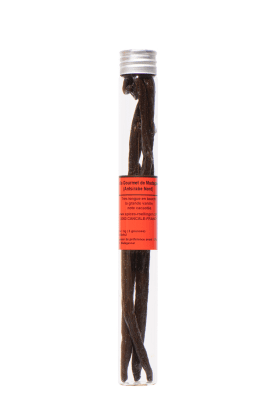Gourmet Madagascar Vanilla Bean

Ingredients: Gourmet Madagascar vanilla bean
The "great" vanilla bean with cocoa flavor notes that linger on the palate.
€13.50
3 vanilla beans (8 g)
This product is temporarily unavailable. Receive an email as soon as this product is available again:
Recommendations
Use to flavor crème anglaise (custard sauce), mousseline pastry cream, real vanilla ice cream, and dessert soufflés.
When high-quality vanilla beans like these, less of the bean is needed to flavor recipes. 1/3 of a vanilla bean is enough for a dessert that serves 4 to 6 people.
To use : split the bean in half lengthwise with a small, sharp knife. Use the back of the knife to scrape out the tiny seeds inside each half of the bean, then add the seeds to the recipe as directed.
When high-quality vanilla beans like these, less of the bean is needed to flavor recipes. 1/3 of a vanilla bean is enough for a dessert that serves 4 to 6 people.
To use : split the bean in half lengthwise with a small, sharp knife. Use the back of the knife to scrape out the tiny seeds inside each half of the bean, then add the seeds to the recipe as directed.
Our recipes
- Origin Madagascar
- Storage / Use Sealed in its glass tube, in a cool, dark, dry place.
€1,687.50 / kg
Olivier Rœllinger's words
Without question, this is one of the largest vanilla beans in the world. It growsin Madagascar, an island in the Indian Ocean that basks in the heat that emanates from the African continent the way a stone set in front of an oven absorbs its warmth. The land, the climate, the altitude, and especially the savoir-faire of the women who grow and prepare vanilla beans in the villages of northeast Madagascar are all without compare.
With cocoa and caramel notes, this is the pastry princess of vanilla beans. It works particularly well in crème anglaise (custard sauce), mousseline pastry creams, real vanilla ice creams, and dessert soufflés.
With cocoa and caramel notes, this is the pastry princess of vanilla beans. It works particularly well in crème anglaise (custard sauce), mousseline pastry creams, real vanilla ice creams, and dessert soufflés.
Story
This vanilla bean is grown and cured near Antsirabe, in the Sava region of northeast Madagascar.
While they are still on the vine, vanilla beans already smell like vanilla. Yet it’s the preparation (curing) of the beans that bring out vanilla’s true fragrance.
The curing process for Vanilla planifolia beans begins with 24 hours of “scarring” just after they are picked. The beans are then are scalded several minutes. This step is part of the curing technique developed according to traditional Mexican methods by Ernest Loupy (1851), a grower on Reunion Island.
After this step the beans are wrapped in large blankets for a 4-week (approximately) period when the beans (still wrapped in the blankets) are spread out to dry in the sun during the day, then brought inside at night to promote ideal fermentation conditions.
Finally, the beans are laid on screens in well-aerated wood huts to cure for 6 months. During this time, the women workers give the beans’ skin a shiny smoothness by massaging them dozens of times with their hands.
At the end, the beans are selected and sorted according to quality.
While they are still on the vine, vanilla beans already smell like vanilla. Yet it’s the preparation (curing) of the beans that bring out vanilla’s true fragrance.
The curing process for Vanilla planifolia beans begins with 24 hours of “scarring” just after they are picked. The beans are then are scalded several minutes. This step is part of the curing technique developed according to traditional Mexican methods by Ernest Loupy (1851), a grower on Reunion Island.
After this step the beans are wrapped in large blankets for a 4-week (approximately) period when the beans (still wrapped in the blankets) are spread out to dry in the sun during the day, then brought inside at night to promote ideal fermentation conditions.
Finally, the beans are laid on screens in well-aerated wood huts to cure for 6 months. During this time, the women workers give the beans’ skin a shiny smoothness by massaging them dozens of times with their hands.
At the end, the beans are selected and sorted according to quality.